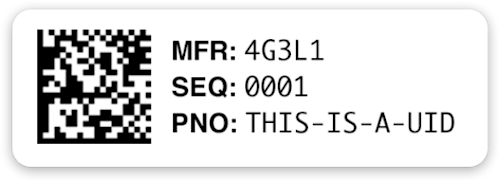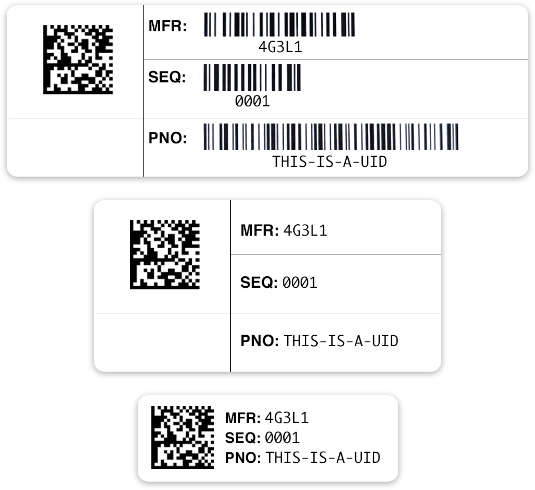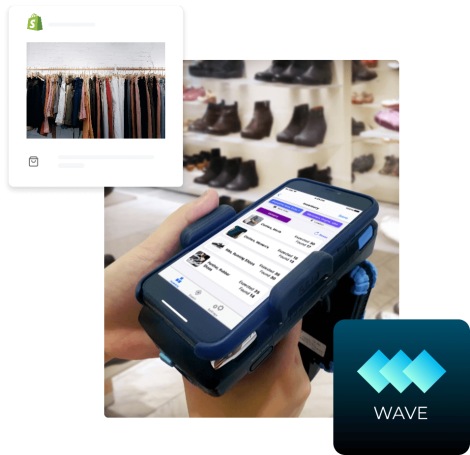What do I need for the MIL-STD-130? (DoD UID Label)

If your company has just started shipping items to the Department of Defense (DoD), the abbreviation UID might be a new one to you. However, it's crucial to know about because the DoD is moving towards making it mandatory for more and more types of shipments.
UID stands for "unique identification". You may also see IUID for "item unique identification." It's the same thing, and it refers to the same mil-std-130N.
For MIL-STD-130N compliance, you simply need a UID label. This label consists of your company's CAGE code, the Part Number of the product, and the item's Serial. There is also a 2D Matrix you can scan containing all of the information printed on the label.
UID Labels 101
UID labels are required on mission-critical items shipped to the DoD, as well as all items worth $5,000 or more. The label must contain specific information about the item and be capable of withstanding the item's life.
DoD Mandate
The mandate number issued by the DoD is MIL-STD-130N. It's about 80 pages. It's a long, dense document, but the important part regarding UID is what's been mentioned. The DoD only asks for the CAGE code, part number, and serial number to produce a unique identification. The CAGE code is the unique five-digit number given to contractors with the Department of Defense. You likely have one already if you have a government contract. Also, the UID label's quality must be graded at least a B rating, referring to the quality of 2D barcode image for contrast and dot-pitch accuracy. SimplyRFiD produces grade-A labels. Grade-A UID Tags require higher quality equipment, but it means, as your image degrades over time, it won't drop below acceptable quality.
The most significant reason systems fail to produce grade-A UID images:
- Contrast. On Black and White labels, this is seldom an issue to get grade-A. If the UID tag production system is not maintained and cleaned correctly, the black may not fill each dot or look like it's running low on ink. Those will usually get a B or lower grade.
The second biggest reason images get graded a B or below:
- Inaccurate dot pitch. SimplyRFiD uses a 600DPI printer to produce super crisp UID and ultra-premium Zebra Resin ribbon for long image life.
Metal plate UID tags have more issues. Since metal plates are often struck-images (hammered into the plate), you have to worry about shadows affecting the performance and grading. The materials used by SimplyRFiD offer a similar lifespan as metal UID tags.
UID Label Sizes

There is no specific requirement for a UID label size.
SimplyRFiD offers three sizes:
-
3"x1" Classic UID Label - This was our first UID label. It has 1D barcodes for the MFG, Serial, and PNO (part number). The 3x1 is a rather large label, and the 1D barcodes are not required. Some customers like it because they scan the 1D barcodes when packing products.
-
2"x1" UID Label - This is our most popular label. A little smaller and has all the info required to meet the mandate.
-
1.5"x0.5" UID Label - A tiny label that solves the problem; however, sometimes the part number is too big to fit.
Customers will often ask for custom information to be included on the label, like contract number. We can do that for a one-time custom label design change.
In-House UID Printer vs. Premade UID Labels?
Are you getting ready to start shipping with UID labels? There are a few options available to you. Your company can print in-house labels after an initial investment in a printer. UID printing systems are expensive but might be worth it if you print a 1,000+ UID labels a month. A 600 DPI printer costs between $3,000 and $5,000. A UID verification System costs about $10,000. If you only need a few labels, you can order them pre-printed with all relevant information already included. SimplyRFiD's pre-printed, certified, verified UID labels are significant cost savings over purchasing a system for lower volumes.
Operating your UID Tag production system requires expertise with printer head tension, print darkness, and label software to design your UID tag and encode part numbers.
Typically, this means a technical resource that can set up and maintain your equipment.
Factor about $3,000 (amortized five-year cost of a UID label printer and UID Verification system) and your break-even is around 5,000 UID tags per-year for in-house tag production vs. outsourced.
UID Construct 0, Construct 1, Construct 2
The MIL-STD-130N allows a lot of options for your part marking. SimplyRFiD uses construct two for most things.
Construct two is:
- Your Companies CAGE code (Enterprise ID)
- Your Part Number
- Your Serial Number
Construct 0 is not currently approved. Construct 0 would be easy (CAGE code and a unique number) -- but it's been 10+ years, and we still haven't seen the approval to provide serialized labels you could place on all your equipment.
Construct 1 is an option but difficult to maintain throughout an organization.
Construct 2 is easy and the best option for most users and included as part of our standard tag UID Tag.
Direct Part Marking (DPM) vs. Labels vs. Metal Plates
Direct part marking is complicated. On airframes, often, there is no other way to place a label or plate. In these instances, a system to etch the part/metal directly is your only option. Costs run into 10's of thousands of dollars for a DPM system. It is slow, laborious, and expensive.
SimplyRFiD uses a high-quality thermal transfer label designed to last the life of the part. Synthetic UID labels last as long as metal UID plates, cost less than metal, and typically ship within a day vs. several days.
What type of UID label material should I use?
SimplyRFiD uses a polyester UID label designed to last the life of any product.
There are many other forms of material from aluminum, metal and metal foil, and other synthetics. We haven't found any material stronger than our selected Zebra Z-Ultimate 4000T polyester combined with the Zebra 5100 resin ribbon for long-lasting image life.
How do I attach my UID Label?
Adhesive or permanent attachment is the most challenging aspect of tagging -- especially for outdoor parts.
The adhesive provided with the SimplyRFiD UID Tags works well on indoor items. It will stick to metal or poly-plastic surfaces for the useful life of the product. If your product is outdoors, the adhesive will perform extremely well, but after 3 to 5 years, it will begin to lose its effectiveness. Consider placing the UID tag under a lucite panel, inside an interior compartment, or adding a PM check step to ensure adherence.
You may also consider a lanyard with product information and the UID label inside the pouch or lanyard.
Installing the label is like anything:
- Clean the surface before applying the label
- Full adhesion will occur after 24 hours
Terminology
These terms refer to the MIL-STD-130N specification and used interchangeably:
- UID Labels: A label produced for the MIL-STD-130N specification. This label is applied to the equipment.
- IUID Labels: Same as UID Label. For a while, the industry referred to UID labels as an IUID. The specification still says IUID, but it's commonly shortened to UID. Or, IUID is the full specification, and UID labels are the end product.
- Army IUID Labels: Same as the MIL-STD-130N
- DoD IUID Labels: Same as the MIL-STD-130N
- EID stands for enterprise ID. The DoD will allow you to choose several options. SimplyRFiD supports the easiest: Your CAGE code. If you have a DoD contract, you already have this, and the military knows who you are.
